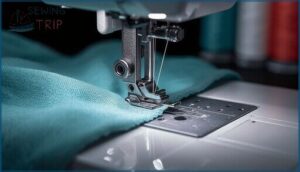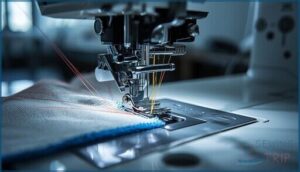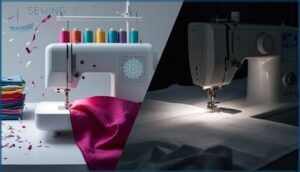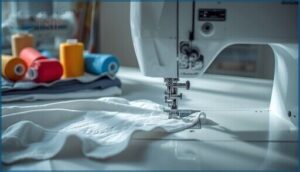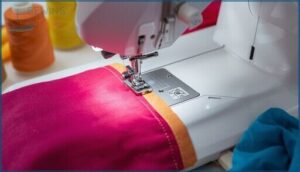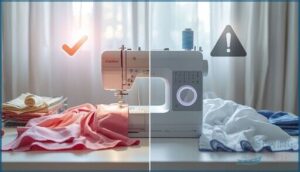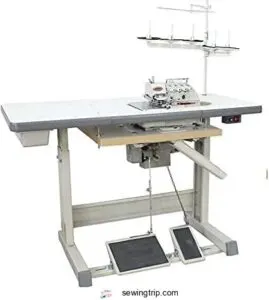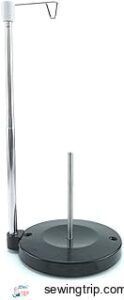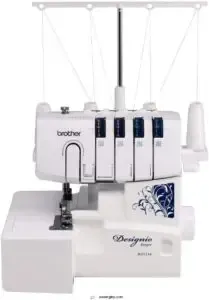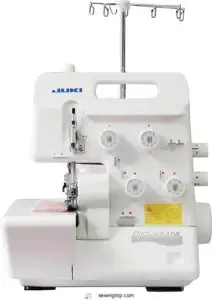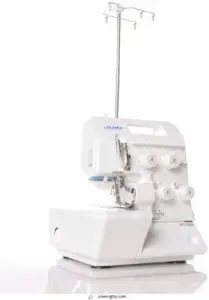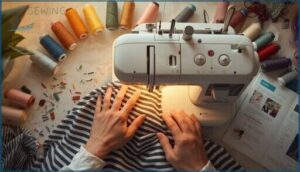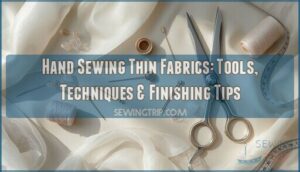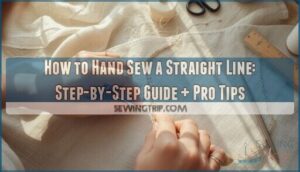This site is supported by our readers. We may earn a commission, at no cost to you, if you purchase through links.
You’re standing in front of your overflowing fabric stash, wondering if that serger gathering dust in the corner could handle more than just finishing edges. Here’s the truth: sergers aren’t traditional sewing machines, but they’re far more adaptable than most sewists realize.
While they can’t replace your trusty machine for everything—forget topstitching or installing zippers—they excel at tasks that would take three times longer on a standard model. The real question isn’t whether you can use a serger for sewing, but which sewing tasks it handles brilliantly and which ones require your regular machine.
Understanding this difference transforms your serger from a one-trick pony into a powerhouse that speeds through stretchy fabrics, locks in professional finishes, and opens creative doors you didn’t know existed.
Table Of Contents
Key Takeaways
- Sergers excel at finishing edges and constructing stretchy seams at speeds up to 1,500 stitches per minute, but they can’t replace your regular sewing machine for tasks like topstitching, buttonholes, or installing zippers.
- The machine uses 3-5 threads with loopers to simultaneously trim, stitch, and encase raw edges in one pass, making it ideal for knits, jerseys, and projects requiring professional-looking seam finishes.
- Threading complexity and tension adjustments present the steepest learning curve, but color-coded guides and practice sessions on scrap fabric help beginners master the technique within weeks.
- Quality sergers range from $200 entry-level models to $1,500+ professional machines, with mid-range options offering the best balance of speed, versatility, and features like differential feed and multiple stitch configurations.
What is a Serger and How It Works
If you’ve ever wondered what sets a serger apart from your regular sewing machine, you’re in the right place. These specialized machines handle specific jobs that make your projects look polished and professional.
Let’s break down what a serger actually is, how it operates, and how it compares to the machine you’re already using.
Definition and Purpose of a Serger
A serger—also called an overlock machine—is your edge-finishing powerhouse. Unlike standard sewing machines, it trims, stitches, and encases raw edges simultaneously using 3 to 5 threads. This efficiency transforms serging basics into a revolutionary tool for fabric handling.
Here’s what sets overlock stitches apart:
- Prevents fraying by wrapping thread around cut edges
- Creates stretchy seams perfect for knits and activewear
- Delivers professional results comparable to ready-to-wear garments
For more information on serger benefits, understanding serger seams is essential for achieving professional-looking finishes.
Key Components and Mechanisms
Understanding how your machine operates unlocks better control. Most sergers use 3 to 4 threads routed through a color-coded threading path—loopers and needles work in sync to form overlock stitches. The cutting system trims fabric before stitching, while feed dogs (controlled by differential feed settings) manage fabric movement.
Mastering tension settings and looper mechanisms transforms serging for beginners into confident, professional-quality work. To improve serger skills, it’s crucial to study serger education resources thoroughly.
Overlock Vs. Regular Sewing Machines
Once you’ve got the threading down, you might wonder what sets overlocking apart from your trusty regular sewing machine. The difference is more than cosmetic—it’s about how each machine builds a seam.
- Stitch Speed: Overlock machines fly at 3,000–8,000 stitches per minute, while regular models cruise around 800–1,500
- Thread Management: Sergers juggle 3–5 threads with loopers; sewing machines rely on needle-and-bobbin lockstitch systems
- Fabric Handling: Overlock trim and finish edges simultaneously—regular machines need separate passes
- Seam Comparison: Lockstitches interlock within fabric; overlock wraps threads around edges for stretch-friendly durability
- Machine Durability: Both excel when maintained, but serging and overlocking shine on knits while sewing techniques on regular machines handle wovens and topstitching
Can You Use a Serger for Sewing?
Yes, you can absolutely use a serger for sewing—but it’s not quite the all-in-one machine some people expect. Sergers excel at specific tasks like finishing edges, constructing stretchy seams, and working with knits, but they can’t replace your regular sewing machine for everything.
A serger excels at edge finishing and stretchy seams, but it’s a specialist tool that can’t replace your regular sewing machine
Let’s break down what a serger can actually handle, where it falls short, and which fabrics and projects are perfect for this speedy machine.
Types of Sewing Tasks a Serger Can Perform
You’ll release serious speed and versatility once you see what a serger manages. Edge finishing is its superpower—wrapping raw edges with neat overlock stitches that stop fraying cold.
For seam construction on knits, nothing beats a four-thread overlock that sews, trims, and finishes simultaneously.
You can tackle rolled hems on delicate fabrics, create flatlock seams for activewear, and even add decorative touches with contrast thread—all while mastering essential serging techniques and thread management.
Limitations Compared to Standard Sewing Machines
While a serger excels at edge finishing and seam construction for knits, fabric constraints and stitch limitations become obvious fast. You can’t start stitching mid-panel—no patch pockets, no buttonholes, no zippers. Machine capabilities stop at edges; straight lockstitching and topstitching stay with your sewing machine.
For beginners comparing serger vs sewing machine, think of serging as your edge specialist, not your all-purpose workhorse.
Suitable Fabrics and Projects for Sergers
Knits, jerseys, and stretchy fabrics are your serger’s sweet spot—overlock stitches flex with the fabric, perfect for garment construction like T-shirts and leggings. Lightweight wovens, chiffon, and satin shine with rolled hems. You’ll also nail seam finishing on medium-weight cottons and home decor projects.
For beginners mastering fabric selection and sewing techniques, start with jersey scraps before tackling swimwear or denim seam edges.
Essential Serger Techniques and Uses
Now that you know what a serger can handle, it’s time to get into the techniques that make these machines indispensable. Whether you’re finishing edges, building durable seams, or adding creative touches, mastering a few core skills unlocks your serger’s full potential.
Let’s break down the essential techniques that’ll take your projects from homemade to handcrafted.
Finishing Raw Edges and Preventing Fraying
Your serger’s greatest strength is taming raw edges—those pesky fabric fringes that unravel faster than your best-laid plans. Edge finishing with an overlock stitch wraps multiple threads around the cut edge, creating serious seam security while trimming excess fabric in one swift pass.
Here’s what makes serger fray prevention unbeatable:
- Full edge encapsulation keeps woven fabrics from shedding threads during handling and laundering
- Fabric stabilization on facings and seam allowances prevents holes from progressive fraying over time
- Professional raw edge treatment rivals factory finishing—faster and more secure than pinking or zigzag stitches
Perfect for serging beginners tackling fray-prone materials.
Seam Construction for Garments
When you’re ready to join seams like the pros do, your serger becomes a garment assembly powerhouse. Overlock seams stitch, trim, and finish in one satisfying pass—cutting construction time dramatically while delivering stretchable, secure joins that won’t pop under stress.
Seam Types for Different Projects:
| Seam Type | Best Fabrics | Common Uses |
|---|---|---|
| 4-thread overlock | Knits, jerseys | T-shirt side seams, activewear |
| 3-thread overlock | Lightweight wovens | Casual garments, edge finishing |
| Safety stitch | Medium wovens | Structured garments needing durability |
| 2-thread flatlock | Stretch fabrics | Decorative athletic wear seams |
Thread tension and fabric selection are crucial for seam strength, with research indicating that proper stitch density can achieve 60-80% seam efficiency. For beginners, practicing on scraps is essential to master tension adjustments and differential feed, ensuring pucker-free results. Side seams, shoulders, and sleeves serve as the ideal training ground to develop sewing efficiency comparable to factory standards.
Decorative Stitches and Special Functions
Think beyond basic seam finishing—your serger’s decorative arsenal rivals many specialty machines. Here’s what you can master:
- Rolled Hems: 1–1.5 mm stitches create elegant edges on sheers and scarves using woolly nylon or metallic thread
- Flatlock Seams: Adjustable tension produces ladder effects perfect for sportswear color-blocking
- Coverstitch Patterns: Parallel rows deliver stretchy, professional hems on knits
- Lettuce Edging: Differential feed below 1.0 creates fluted ripples on lightweight fabrics
- Chainstitch Decoration: Contrasting thread setup highlights topstitching with visible loops
Tension adjustment transforms functional stitches into showstopping design elements—experiment freely with thread and feed settings to discover your serger’s full creative range.
Benefits and Drawbacks of Sergers
Every tool has its strengths and weaknesses, and sergers are no exception. Understanding what they excel at—and where they fall short—helps you decide when to reach for your serger and when to stick with your regular machine.
Let’s break down the key advantages and limitations you’ll want to keep in mind.
Speed and Efficiency Advantages
If you’ve ever watched fabric fly through a serger, you know the machine lives up to its reputation for high-speed sewing. Most consumer models stitch at 1,200–1,500 stitches per minute—roughly double what your regular machine can do.
That means efficient edge finishing and fast fabric handling in one pass, trimming and overcasting simultaneously.
For serging beginners mastering these time-saving tips, the productivity hacks are real: you’ll breeze through seams that once ate up your afternoon.
Professional-Quality Results
Speed is one thing, but what really sets sergers apart is the polished look they bring to your work. When you open a store-bought T-shirt and see those tidy, encased seams—that’s overlock stitching. Your home serger replicates the same edge control and fabric selection pros use in ready-to-wear, giving you:
- Clean seam finishing that prevents fraying
- Stretchy construction perfect for knits and activewear
- Consistent professional appearance inside and out
- Enhanced garment durability through proper serging for beginners
Professional sewing finishing suddenly becomes accessible, and sewing with a serger means your handmade pieces rival anything off the rack.
Common Limitations and When to Use a Sewing Machine
Sergers excel at edge finishing, but serging limitations mean you can’t rely on them alone. Fabric constraints arise with thick layers—denim or canvas often overwhelms the blade.
Sewing alternatives become necessary for buttonholes, zippers, topstitching, and seams pressed open.
Machine comparison shows that even professionals keep a conventional sewing machine for these tasks, making sergers complementary tools rather than replacements.
Top 5 Serger Machines for Home Sewing
Now that you know what a serger can do and where it falls short, let’s talk about the machines that’ll actually get the job done.
I’ve rounded up five solid options that home sewers trust for everything from basic edge finishing to more intricate garment work. Each one brings something different to the table, so you can find the right fit for your sewing space and budget.
1. Brother Overlock Sewing Machine DZ1234
You’ll appreciate the Brother DZ1234‘s color-coded threading guides—they cut through the intimidation factor that stops many beginners cold. This overlock machine rockets along at 1,300 stitches per minute, turning tedious edge-finishing into a satisfying blur of productivity.
The differential feed manages stretchy knits without puckering, while the metal frame keeps vibration in check during high-speed serging.
With three specialty feet, two thread sets, and standard needle compatibility, this serger delivers serious value for anyone ready to level up their fabric handling and machine durability without wrestling industrial-grade complexity.
Best For: Beginners and intermediate sewers who want professional-looking seam finishes on knits and wovens without the learning curve of industrial machines.
- Color-coded threading guides and included instructional materials make setup surprisingly straightforward for first-time serger users.
- The 1,300-stitch-per-minute speed and differential feed handle stretchy fabrics quickly while preventing puckering and waviness.
- Comes with three specialty feet, two thread sets, and uses standard needles—you can start projects immediately without hunting down proprietary parts.
- At 18.1 pounds, it’s not the lightest option if you need to move it between spaces regularly.
- The Yamata FY7x7A facts seem mixed into Brother DZ1234 details, making it unclear which limitations apply to this specific model.
- Limited information on long-term durability means you’re relying more on the accessory bundle than verified construction quality.
2. Juki Portable Thread Serger Sewing Machine
When you’re chasing raw speed and precision, the Juki portable serger hits a blistering 1,500 stitches per minute—that’s nearly 6–9 times faster than your sewing machine’s overcast stitch.
Color-coded threading guides and industrial-type tension dials demystify serger maintenance and thread tension adjustments, so you’ll master overlock techniques without guesswork.
The differential feed manages fabric compatibility from delicate chiffon to stretchy knits, while 2-, 3-, and 4-thread configurations enable everything from rolled hems to flatlock seams.
For serging beginners craving control and sewing speed, this Juki delivers professional-grade results in a compact, 15-pound package.
Best For: Sewers who want to finish garment edges quickly and professionally, especially those working with knits or handling high-volume projects where speed and clean seam finishes matter.
- Blazing 1,500 stitches per minute makes edge finishing and seam construction dramatically faster than regular sewing machines
- Color-coded threading guides and quick-access lower looper cut down the intimidation factor and get you serging in minutes
- Differential feed and multiple thread configurations handle everything from delicate rolled hems to stretchy activewear seams
- Threading a serger still takes practice, even with the guides—expect a learning curve if you’ve never used one
- The 15-pound weight and compact footprint are portable, but it’s another machine to store and maintain alongside your regular sewing setup
- Some accessories and advanced feet may need to be purchased separately depending on your dealer’s bundle
3. Juki MO644D Portable Serger Machine
The Juki MO644D merges portability with serious sewing efficiency. At just 15 pounds, you’ll easily move this serger between workspaces while tapping into 1,500 stitches per minute for rapid seam finishing.
Its color-coded thread management system and breakaway lower looper simplify serging for beginners, and the differential feed (0.7–2.0) guarantees fabric compatibility from jersey to chiffon.
With 2-, 3-, and 4-thread configurations plus a built-in rolled hem, you’re equipped for diverse projects. Routine serger maintenance stays straightforward thanks to accessible tension dials, making this sewing machine and serger combo a practical gateway to professional results.
Best For: Sewers who want a lightweight, fast serger that’s easy to thread and handles multiple stitch types without the bulk of industrial machines.
- Speeds through seams at 1,500 stitches per minute, cutting project time significantly compared to standard sergers
- Color-coded threading and breakaway lower looper make setup quick, even if you’re new to serging
- Handles 2-, 3-, and 4-thread stitches plus built-in rolled hems, giving you flexibility across different fabrics and finishes
- The 5mm presser foot lift limits how many layers you can work with, making thick fabrics tricky
- Struggles with very heavy materials, so it’s not ideal if you regularly sew denim or upholstery
- Mid-range price point means you’re paying more than budget sergers, though the speed and features help justify the cost
4. Singer Professional Serger Overlock Machine
The Singer Professional 5 14T968DC stands apart with 2-to-5-thread versatility and coverstitch capability, bridging the gap between standard overlock techniques and sophisticated garment construction.
You’ll appreciate its self-adjusting tension—no more guesswork with thread management—and a color-coded system that simplifies serging for beginners while saving precious sewing efficiency.
At 1,300 stitches per minute, this overlock machine manages everything from delicate knits to heavy canvas, and the free-arm design makes tubular fabric handling uncomplicated.
Routine serger maintenance stays manageable thanks to the removable trim trap and accessible threading diagrams. It’s a powerhouse for serious home sewers ready to enhance their craft.
Best For: Serious home sewers and small business owners who need professional finishing on everything from lightweight knits to heavy fabrics and want coverstitch capability without buying a separate machine.
- 2-to-5-thread flexibility with coverstitch lets you handle professional hemming, seam finishing, and decorative stitching all in one machine
- Self-adjusting tension and color-coded threading take the guesswork out of setup, especially helpful when switching between different stitch configurations
- Heavy-duty frame and 1,300 stitches per minute give you the speed and stability to power through thick layers and long production runs
- Threading complexity can frustrate beginners even with the color-coded system—expect a learning curve if you’re new to sergers
- No coverstitch or coverhem capability (based on the 14T968DC model specs, though the Professional 5 variant adds this)
- Noise level during high-speed operation may be louder than standard domestic sewing machines
5. Brother ST4031HD Serger Overlock Machine
The Brother ST4031HD brings serious muscle to your sewing room with a heavy-duty metal frame that handles denim, canvas, and layered knits without breaking a sweat.
This overlock machine runs at 1,300 stitches per minute with adjustable differential feed (0.7 to 2.0 ratio) for fabric edge finishing on everything from delicate jerseys to tough textiles.
Color-coded threading and serger accessories like the trim trap make serger maintenance straightforward, while serging for beginners becomes less intimidating. Its disengageable blade expands your overlock techniques beyond basic edge work.
Best For: Home sewers and small workshop operators who regularly work with heavy fabrics like denim and canvas and need a fast, durable serger that can handle both thick layers and delicate materials.
- Heavy-duty metal frame and extra-hard carbon steel blade power through multiple layers of thick fabric at 1,300 stitches per minute
- Adjustable differential feed (0.7–2.0 ratio) prevents puckering on knits and stretching on lightweight fabrics
- Color-coded threading guides and included accessories (blind-stitch foot, gathering foot, trim trap) make setup easier and expand creative options
- At around 17.64 lb, it’s heavier than many beginner sergers, making it less portable
- Not compatible with elastic threads, limiting some specialized stretch applications
- Replacement blades are a consumable cost to factor in with heavy use on tough materials
Tips for Getting Started With a Serger
Getting started with a serger doesn’t have to feel overwhelming, even if threading looks like a puzzle at first glance. The key is breaking the learning curve into manageable steps—from mastering the basics of threading and tension to choosing the right practice projects.
Let’s walk through the essentials that’ll have you confidently finishing seams in no time.
Threading and Tension Basics
Threading and tensioning your serger might feel like weaving a puzzle, but mastering thread management unlocks pro-level seam construction. Start by following the threading order—upper looper, lower looper, then needles—with the presser foot raised. Set tension settings to mid-range (around 4) for stitch balance, then test on scraps.
Balanced thread setup means looper threads meet perfectly at the fabric edge, giving you complete control over fabric handling.
Practice Projects for Beginners
Start with napkin sewing or pillowcase construction—you’ll master edge finishing without pressure. Try rolled hems on lightweight scarves, then move to garment basics like simple leggings.
These serging for beginners projects build confidence through repetition. Fabric finishing on cleaning cloths lets you practice serging tips risk-free.
Each project sharpens your sewing for beginners skills, giving you complete control over serging techniques.
Maintenance and Safety Guidelines
Think of your serger as a high-speed athlete—it needs proper care to perform. Unplug before any threading or needle changes to avoid injury. Keep your workspace dry and well-lit for electrical safety, and clear lint around loopers after each session.
Regular cleaning prevents jammed mechanisms, while routine machine inspection catches worn needles early. Oil only if your manual specifies it—these serging tips protect both you and your investment.
Frequently Asked Questions (FAQs)
How does the threading process differ between a serger and a sewing machine?
Ever wonder why your serger feels like puzzle-solving while your sewing machine doesn’t? Threading a serger requires routing 3-5 separate threads through multiple loopers and tension controls, whereas sewing machines use just two thread sources.
Can a serger be used for quilting projects, and what are the best practices for doing so?
Yes, sergers work beautifully for strip quilts and quilt-as-you-go projects. Use a wide 4-thread overlock, test your settings on scrap sandwiches, and press seams to one side for the cleanest results.
Can sergers replace conventional sewing machines completely?
Sergers can’t fully replace sewing machines. While overlock stitches excel at edge finishing and garment construction, you’ll still need your machine for buttonholes, zippers, and precise topstitching that serger limitations prevent.
How much does a quality serger cost?
Quality serger pricing spans a wide range—entry-level models start around $200 to $500, mid-range options run $500 to $1,200, and premium machines with sophisticated features can reach $1,500 or higher.
What thread types work best with sergers?
Regarding thread materials, you’ll want to spin this choice carefully. Polyester threads deliver durability for most serging tasks, while cotton blends work beautifully with natural fabrics, ensuring smooth thread setup and professional seam quality.
Are sergers difficult to learn for beginners?
Threading can feel tricky at first—99% of beginner issues trace back to slight threading mistakes.
But with practice sessions spanning 8 weeks, you’ll master the learning curve, speed control, and essential serging tips and tricks.
Do sergers work well with thick fabrics?
Thick layers put your machine through its paces! Heavy duty serging manages dense material sewing and stretchy fabrics well—if you’ve got the right setup.
Fabric thickness limits, proper serger thread tension, and correct fabric finishing techniques make all the difference.
Conclusion
Think of your serger as the specialized teammate your sewing machine never knew it needed—not a replacement, but a partner that crushes seams and finishes while your standard machine manages the detail work.
Yes, you can use a serger for sewing, especially when speed and stretch matter. Thread one up, run a few practice seams, and you’ll wonder how you ever hemmed knits or finished raw edges without it.
- https://www.ageberry.com/what-is-serger/
- https://publications.mgcafe.uky.edu/files/fcs2802.pdf
- https://www.seamwork.com/fabric-guides/do-i-really-need-a-serger
- https://www.reddit.com/r/sewhelp/comments/1edswev/do_i_need_to_sew_regularly_if_i_use_a_serger/
- https://www.threadsmagazine.com/forum/using-both-sewing-machine-serger


